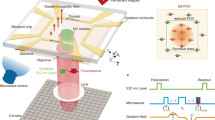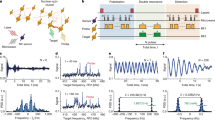Abstract
Magnetic resonance imaging (MRI) has revolutionized biomedical science by providing non-invasive, three-dimensional biological imaging1. However, spatial resolution in conventional MRI systems is limited to tens of micrometres2, which is insufficient for imaging on molecular scales. Here, we demonstrate an MRI technique that provides subnanometre spatial resolution in three dimensions, with single electron-spin sensitivity. Our imaging method works under ambient conditions and can measure ubiquitous ‘dark’ spins, which constitute nearly all spin targets of interest. In this technique, the magnetic quantum-projection noise of dark spins is measured using a single nitrogen-vacancy (NV) magnetometer located near the surface of a diamond chip. The distribution of spins surrounding the NV magnetometer is imaged with a scanning magnetic-field gradient. To evaluate the performance of the NV-MRI technique, we image the three-dimensional landscape of electronic spins at the diamond surface and achieve an unprecedented combination of resolution (0.8 nm laterally and 1.5 nm vertically) and single-spin sensitivity. Our measurements uncover electronic spins on the diamond surface that can potentially be used as resources for improved magnetic imaging. This NV-MRI technique is immediately applicable to diverse systems including imaging spin chains, readout of spin-based quantum bits, and determining the location of spin labels in biological systems.
This is a preview of subscription content, access via your institution
Access options
Subscribe to this journal
Receive 12 print issues and online access
$259.00 per year
only $21.58 per issue
Buy this article
- Purchase on Springer Link
- Instant access to full article PDF
Prices may be subject to local taxes which are calculated during checkout




Similar content being viewed by others
References
Mansfield, P. Snapshot magnetic resonance imaging (Nobel lecture). Angew. Chem. Int. Ed. 43, 5456–5464 (2004).
Glover, P. & Mansfield, P. Limits to magnetic resonance microscopy. Rep. Prog. Phys. 65, 1489–1511 (2002).
Palma, C-A. & Samori, P. Blueprinting macromolecular electronics. Nature Chem. 3, 431–436 (2011).
Cai, J., Retzker, A., Jelezko, F. & Plenio, M. B. A large-scale quantum simulator on a diamond surface at room temperature. Nature Phys. 9, 168–173 (2013).
Sidles, J. A. et al. Magnetic resonance force microscopy. Rev. Mod. Phys. 67, 249–265 (1995).
Balasubramanian, G. et al. Nanoscale imaging magnetometry with diamond spins under ambient conditions. Nature 455, 648–651 (2008).
Degen, C. L., Poggio, M., Mamin, H. J., Rettner, C. T. & Rugar, D. Nanoscale magnetic resonance imaging. Proc. Natl Acad. Sci. USA 106, 1313–1317 (2009).
Rugar, D., Budakian, R., Mamin, H. J. & Chui, B. W. Single spin detection by magnetic resonance force microscopy. Nature 430, 329–332 (2004).
Grinolds, M. S. et al. Quantum control of proximal spins using nanoscale magnetic resonance imaging. Nature Phys. 7, 687–692 (2011).
Maletinsky, P. et al. A robust scanning diamond sensor for nanoscale imaging with single nitrogen-vacancy centres. Nature Nanotech. 7, 320–324 (2012).
Grotz, B. et al. Sensing external spins with nitrogen-vacancy diamond. New J. Phys. 13, 055004 (2011).
Mamin, H. J. et al. Nanoscale nuclear magnetic resonance with a nitrogen-vacancy spin sensor. Science 339, 557–560 (2013).
Mamin, H. J., Sherwood, M. H. & Rugar, D. Detecting external electron spins using nitrogen-vacancy centers. Phys. Rev. B 86, 195422 (2012).
Staudacher, T. et al. Nuclear magnetic resonance spectroscopy on a (5 nm)3 sample volume. Science 339, 561–563 (2013).
Steinert, S. et al. Magnetic spin imaging under ambient conditions with sub-cellular resolution. Nature Commun. 4, 1607 (2013).
Ermakova, A. et al. Detection of a few metallo-protein molecules using color centers in nanodiamonds. Nano Lett. 13, 3305–3309 (2013).
Gruber, A. et al. Scanning confocal optical microscopy and magnetic resonance on single defect centers. Science 276, 2012–2014 (1997).
De Lange, G. et al. Controlling the quantum dynamics of a mesoscopic spin bath in diamond. Sci. Rep. 2, 382 (2012).
Larsen, R. G. & Singel, D. J. Double electron–electron resonance spin–echo modulation: spectroscopic measurement of electron spin pair separations in orientationally disordered solids. J. Chem. Phys. 98, 5134–5146 (1993).
Schoenfeld, R. S. & Harneit, W. Real time magnetic field sensing and imaging using a single spin in diamond. Phys. Rev. Lett. 106, 030802 (2011).
Grinolds, M. S. et al. Nanoscale magnetic imaging of a single electron spin under ambient conditions. Nature Phys. 9, 215–219 (2013).
Ofori-Okai, B. K. et al. Spin properties of very shallow nitrogen vacancy defects in diamond. Phys. Rev. B 86, 081406 (2012).
Ohno, K. et al. Engineering shallow spins in diamond with nitrogen delta-doping. Appl. Phys. Lett. 101, 082413 (2012).
Dolde, F. et al. Room-temperature entanglement between single defect spins in diamond. Nature Phys. 9, 139–143 (2013).
Tetienne, J. P. et al. Spin relaxometry of single nitrogen-vacancy defects in diamond nanocrystals for magnetic noise sensing. Phys. Rev. B 87, 235436 (2013).
McGuinness, L. P. et al. Ambient nanoscale sensing with single spins using quantum decoherence. New J. Phys. 15, 073042 (2013).
Shi, F. et al. Quantum logic readout and cooling of a single dark electron spin. Phys. Rev. B 87, 195414 (2013).
Yao, N. Y. et al. Robust quantum state transfer in random unpolarized spin chains. Phys. Rev. Lett. 106, 040505 (2011).
Harneit, W. Fullerene-based electron-spin quantum computer. Phys. Rev. A 65, 032322 (2002).
Altenbach, C., Marti, T., Khorana, H. & Hubbell, W. Transmembrane protein structure: spin labeling of bacteriorhodopsin mutants. Science 248, 1088–1092 (1990).
Kaufmann, S. et al. Detection of atomic spin labels in a lipid bilayer using a single-spin nanodiamond probe. Proc. Natl Acad. Sci. USA 110, 10894–10898 (2013).
Belthangady, C. et al. Dressed-state resonant coupling between bright and dark spins in diamond. Phys. Rev. Lett. 110, 157601 (2013).
Laraoui, A. & Meriles, C. A. Approach to dark spin cooling in a diamond nanocrystal. ACS Nano 7, 3403–3410 (2013).
Schaffry, M., Gauger, E. M., Morton, J. J. L. & Benjamin, S. C. Proposed spin amplification for magnetic sensors employing crystal defects. Phys. Rev. Lett. 107, 207210 (2011).
Goldstein, G. et al. Environment-assisted precision measurement. Phys. Rev. Lett. 106, 140502 (2011).
Acknowledgements
The authors thank S. Kolkowitz, N. de Leon and C. Belthangady for technical discussions regarding optimizing NV-based sensors and M. Markham and Element Six for providing diamond samples. The authors acknowledge discussions on the detection of dark spins using DEER with M. D. Lukin, A. Sushkov, I. Lovchinsky, N. Chisholm, S. Bennett, and N. Yao. M.S.G. is supported through fellowships from the Department of Defense (NDSEG programme) and the National Science Foundation. M.W. is supported through a Marie Curie Fellowship and K.D.G. acknowledges support from the Harvard Quantum Optics Center as an HQOC postdoctoral fellow. This work was supported by the DARPA QuEST and QuASAR programmes and the MURI QuISM.
Author information
Authors and Affiliations
Contributions
M.S.G., M.W. and A.Y. conceived the basic principles of NV-MRI. M.S.G., S.H., P.M. and A.Y. built the combined atomic force and confocal microscope for NV experiments. M.S.G. and A.Y. performed the experiments and analysed the data with input from all authors. All authors contributed to writing the manuscript.
Corresponding author
Ethics declarations
Competing interests
The authors declare no competing financial interests.
Supplementary information
Supplementary information
Supplementary Information (PDF 2018 kb)
Rights and permissions
About this article
Cite this article
Grinolds, M., Warner, M., De Greve, K. et al. Subnanometre resolution in three-dimensional magnetic resonance imaging of individual dark spins. Nature Nanotech 9, 279–284 (2014). https://doi.org/10.1038/nnano.2014.30
Received:
Accepted:
Published:
Issue Date:
DOI: https://doi.org/10.1038/nnano.2014.30
This article is cited by
-
Three-dimensional magnetic resonance tomography with sub-10 nanometer resolution
npj Quantum Information (2024)
-
Thermal-activated escape of the bistable magnetic states in 2D Fe3GeTe2 near the critical point
Communications Physics (2023)
-
Probing many-body dynamics in a two-dimensional dipolar spin ensemble
Nature Physics (2023)
-
Single-electron spin resonance detection by microwave photon counting
Nature (2023)
-
Sub-micron spin-based magnetic field imaging with an organic light emitting diode
Nature Communications (2023)



